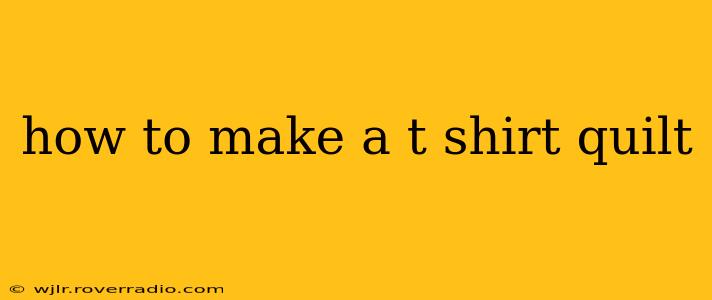Turning your cherished collection of t-shirts into a cozy and unique quilt is a rewarding project. This comprehensive guide will walk you through the process, from selecting your shirts to binding your finished masterpiece. Whether you're a seasoned quilter or a complete beginner, this step-by-step approach will help you create a treasured heirloom.
Choosing Your T-Shirts: The Foundation of Your Quilt
Before you even think about needles and thread, carefully consider the t-shirts you'll use. The quality and type of fabric will significantly impact the final look and feel of your quilt.
- Fabric Selection: Opt for t-shirts made from 100% cotton. These are easier to work with and will hold up better over time than blends. Avoid shirts with heavily embellished designs or those that are excessively stretched or faded.
- Shirt Quantity: The number of shirts you need depends on the desired size of your quilt. A standard throw quilt might require 15-20 shirts, while a larger quilt could easily use 30 or more.
- Color and Design Coordination: While a chaotic mix can be charming, consider organizing your shirts by color or theme to create a more cohesive design.
Preparing Your T-Shirts: Getting Ready to Sew
Once you've chosen your shirts, it's time to prep them for quilting. This crucial step ensures a smoother sewing process and a professionally finished quilt.
- Washing and Drying: Wash and dry your t-shirts before cutting. This pre-shrinks the fabric, preventing shrinkage after the quilt is completed.
- Cutting the Squares: Decide on the size of your squares. 12-inch squares are a common choice, but you can adjust this based on your preference and the size of your t-shirts. Using a rotary cutter and self-healing mat makes this process much faster and more accurate.
- Square Stability (Optional but Recommended): For a more professional look and feel, consider using a fusible interfacing or a lightweight stabilizer on the back of each square. This helps to prevent stretching and maintains the shape of the squares throughout the quilting process.
How to stabilize t-shirt squares for quilting?
This is a frequently asked question. The key is to choose a stabilizer that won’t add too much bulk but will provide enough support to prevent the t-shirt fabric from stretching or distorting during the quilting process. Fusible interfacing is a popular choice; simply iron it to the back of each square according to the manufacturer's instructions. Alternatively, you can use a lightweight fabric stabilizer and stitch it to the back of each square.
Assembling the Quilt Top: Creating the Design
This stage involves arranging your prepared t-shirt squares into your desired pattern.
- Layout: Lay out your squares on a large flat surface to visualize your quilt design. Experiment with different arrangements until you're satisfied.
- Sewing the Rows: Sew the squares together to form rows, using a ¼-inch seam allowance. Press the seams open to prevent bulk.
- Joining the Rows: Once all the rows are sewn, sew them together to complete the quilt top. Again, use a ¼-inch seam allowance and press the seams open.
Quilting: Adding Strength and Style
Quilting involves stitching the layers of your quilt together. This strengthens the quilt and adds a decorative element.
- Layering: Layer your quilt top, batting (a soft, fluffy material), and backing fabric (choose a durable cotton fabric). Baste the layers together using safety pins or basting spray to prevent shifting.
- Quilting Methods: You can choose from various quilting methods, such as straight-line quilting, free-motion quilting, or using a walking foot. Straight-line quilting is the simplest, while free-motion allows for more creative designs.
- Quilt Density: The density of your quilting affects the quilt’s durability and look. Closer stitching results in a stronger, more stable quilt.
What type of batting is best for t-shirt quilts?
Several batting options work well for t-shirt quilts, each with its pros and cons. Cotton batting is a popular and breathable choice, while polyester batting offers more durability and warmth. A blend of cotton and polyester often strikes a balance between the two. Consider the climate where the quilt will be used and your personal preferences when making your decision.
Binding Your Quilt: The Finishing Touches
Binding provides a professional finish to your quilt and protects the edges from fraying.
- Choosing Bias Binding: Pre-made bias binding is easiest for beginners, while making your own adds a personalized touch.
- Attaching the Binding: Sew the binding to the quilt’s edges, using a ¼-inch seam allowance. Fold the binding over the raw edges and sew it down to create a clean finish.
Enjoy Your T-Shirt Quilt!
With a little patience and effort, you can transform a pile of old t-shirts into a cherished, one-of-a-kind quilt. Remember to enjoy the process, and don't be afraid to experiment and personalize your design. Your finished quilt will be a unique and lasting reminder of your memories.
